Natural History and Astrology
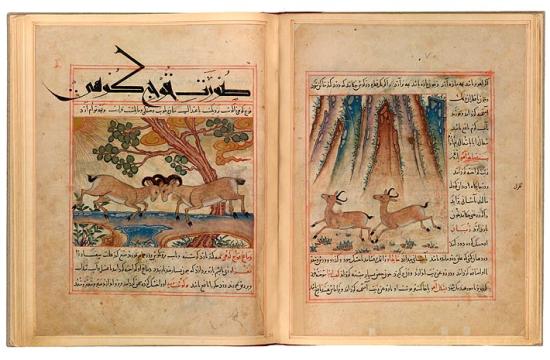
Two Gazelles and Two Mountain Rams
Manāfi˓-i ḥayavān (The Benefits of Animals), in Persian, for Shams al-Dīn Ibn Ẓiyā˒ al-Dīn al-Zūshkī
Purchased by Pierpont Morgan, 1912
Manāfi˓-i ḥayavān (The Benefits of Animals) ranked among the ten greatest Persian manuscripts, dates from the reign of Ghazan Khan (1295–1304), the Mongol ruler who ordered a Persian translation of the book. The Mongol invasion, culminating in the conquest of Baghdad, brought a new, Chinese naturalist style to Persian art. The text discusses the nature and medicinal properties of humans, animals, birds, reptiles, fish, and insects. On the right, two gazelles run in front of a steep, rocky mountainside, kicking up dust (derived from a misunderstood misty landscape model), while on the left two mountain rams fight on a fanciful Chinese-style bridge composed of colored rocks, with gold clouds in the sky.
The manuscript was made at Maragha (south of Tabriz), a center of learning. It was there that Hulagu Khan (r. 1217-1265) built the famous observatory for Nasīr al-Dīn al-Ṭusī, the famous schlar and astronomer.
Natural History and Astrology
The miniatures presented here derive primarily from two extraordinary Islamic manuscripts that depict the natural world and the heavens. The first, Manāfi˓-i hayavān (The Benefits of Animals), is considered one of the ten greatest surviving Persian manuscripts. It dates from the reign of Ghazan Khan (1295–1304), the Mongol ruler who ordered a Persian translation of the book, and concerns the nature and medicinal properties of humans, animals, birds, reptiles, fish, and insects. The other, Matāli˓ al-sa˓āda wa manābi˓ al-siyāda (The Ascension of Propitious Stars and Sources of Sovereign), was commissioned by Sultan Murād III (r. 1574–95), an Ottoman ruler deeply interested in astronomy, cosmology, demonology, poetry, and mysticism.
Two Elephants
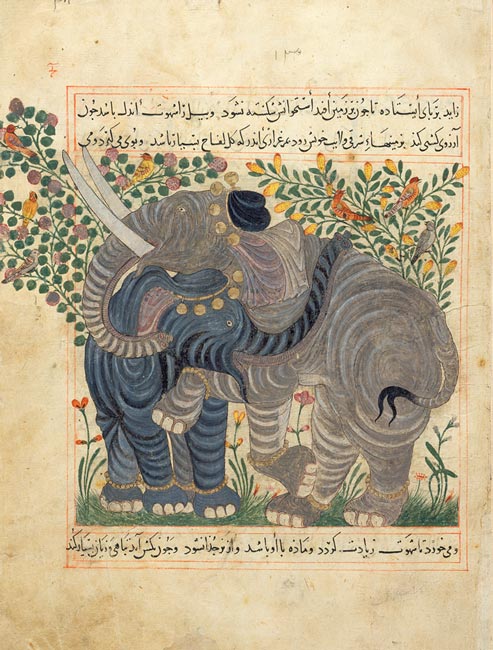
Two Elephants
Manāfi˓-i ḥayavān (The Benefits of Animals), in Persian, for Shams al-Dīn Ibn Ẓiyā˒ al-Dīn al-Zūshkī
Purchased by Pierpont Morgan, 1912
The two interlocking and rather affectionate elephants shown here make up one of the finest of the forty-four large illustrations in the manuscript Manāfi˓-i ḥayavān (The Benefits of Animals). They are royal elephants, as seen from their caps and the bells on their feet. The text describes both the habits and medicinal derivatives of the animal. Among the former, for example, it is stated that the tongue of the elephant is upside down, for if it were not, it could speak, and that the elephant was called "barrus on account of its voice, whence the voice is called baritone." Among the latter—and these have not been tested by the Morgan—are suggestions that elephant broth is good for colds and asthma, that elephant dung (taken with or without honey) prevents conception, and that one dram of ivory filings will bring about conception.
Tiger
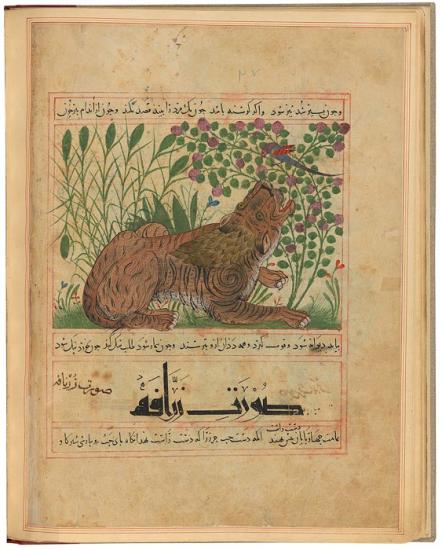
Tiger
Manāfi˓-i ḥayavān (The Benefits of Animals), in Persian, for Shams al-Dīn Ibn Ẓiyā˒ al-Dīn al-Zūshkī
Purchased by Pierpont Morgan, 1912
This illustration appears in the great Persian manuscript Manāfi˓-i ḥayavān (The Benefits of Animals). The recumbent lion raises its head, appearing to converse with the bird in the flowering bush above. The text mentions no medical derivatives of the tiger. Under the reeds are traces of a sketch, in red, of a camel facing left, indicating that the paper was reused.
Natural History and Astrology
The miniatures presented here derive primarily from two extraordinary Islamic manuscripts that depict the natural world and the heavens. The first, Manāfi˓-i hayavān (The Benefits of Animals), is considered one of the ten greatest surviving Persian manuscripts. It dates from the reign of Ghazan Khan (1295–1304), the Mongol ruler who ordered a Persian translation of the book, and concerns the nature and medicinal properties of humans, animals, birds, reptiles, fish, and insects. The other, Matāli˓ al-sa˓āda wa manābi˓ al-siyāda (The Ascension of Propitious Stars and Sources of Sovereign), was commissioned by Sultan Murād III (r. 1574–95), an Ottoman ruler deeply interested in astronomy, cosmology, demonology, poetry, and mysticism.
Camel
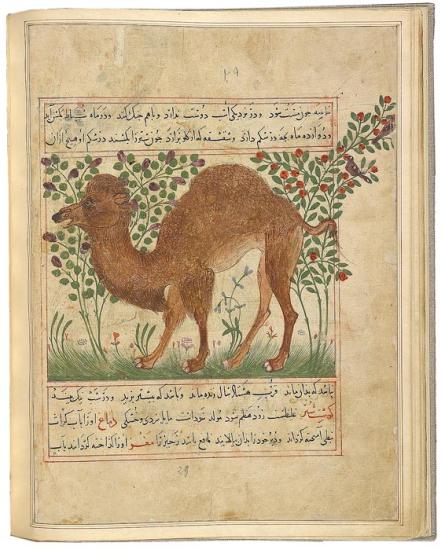
Camel
Manāfi˓-i ḥayavān (The Benefits of Animals), in Persian, for Shams al-Dīn Ibn Ẓiyā˒ al-Dīn al-Zūshkī
Purchased by Pierpont Morgan, 1912
This illustration appears in the great Persian manuscript Manāfi˓-i ḥayavān (The Benefits of Animals). The camel's forelegs are too short, suggesting that the artist's model was too large to fit the available space, and its head has a strange pompadour of hair, perhaps to compensate for the short legs. According to the text the camel is revengeful and thus has a good memory. They conceive in February, have a twelve-month gestation period, and hate the company of horses, as they always fight. Different parts of the camel were used medicinally. Its hump, for example, is good for dysentary; melted and mixed with chive juice it relieves the pain caused by piles.
Natural History and Astrology
The miniatures presented here derive primarily from two extraordinary Islamic manuscripts that depict the natural world and the heavens. The first, Manāfi˓-i hayavān (The Benefits of Animals), is considered one of the ten greatest surviving Persian manuscripts. It dates from the reign of Ghazan Khan (1295–1304), the Mongol ruler who ordered a Persian translation of the book, and concerns the nature and medicinal properties of humans, animals, birds, reptiles, fish, and insects. The other, Matāli˓ al-sa˓āda wa manābi˓ al-siyāda (The Ascension of Propitious Stars and Sources of Sovereign), was commissioned by Sultan Murād III (r. 1574–95), an Ottoman ruler deeply interested in astronomy, cosmology, demonology, poetry, and mysticism.
Iskandar and Khiżr
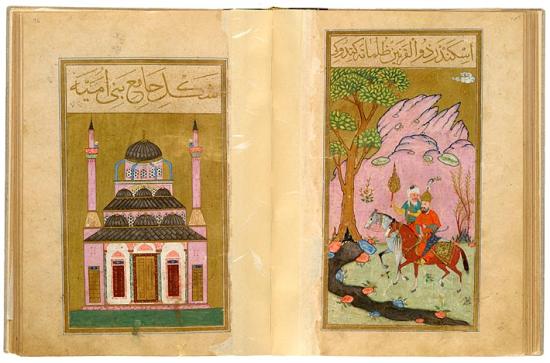
Iskandar and Khiżr Seek the Water of Eternal Life and the Mosque of the Bani Umayya
Maṭāli˓ al-sa˓āda wa manābi˓ al-siyāda (The Ascension of Propitious Stars and Sources of Sovereign), in Turkish
Illuminated by Vali Jan for ˓Āyisha Sulṭān (d.1604), the daughter of Sultan Murād III
Purchased in 1935
This book, made for ˓Āyisha Sulṭān (the daughter of Sultān Murad III), , contains texts relating to astrology, wonders of the world, talismans, and divination. These two miniatures illustrate the second section. Here Iskandar (Alexander the Great) and Khiżr (the green one) enter the Land of Darkness in search of the Fountain of Life. Khiżr, holding a torch, glances at Iskandar. Although the mosque on the left is identified as the ancient mosque of the Umayyads (ca. 650–751) in Damascus, the artist depicted a typical sixteenth-century Ottoman mosque. A twin manuscript painted by ˓Osmān in Paris (BnF, Suppl. turc 242) was made for Fāṭima Sulṭān, another daughter of the Ottoman ruler/bibliophile Murād III (r. 1574–1595) who commissioned the translation.
Natural History and Astrology
The miniatures presented here derive primarily from two extraordinary Islamic manuscripts that depict the natural world and the heavens. The first, Manāfi˓-i hayavān (The Benefits of Animals), is considered one of the ten greatest surviving Persian manuscripts. It dates from the reign of Ghazan Khan (1295–1304), the Mongol ruler who ordered a Persian translation of the book, and concerns the nature and medicinal properties of humans, animals, birds, reptiles, fish, and insects. The other, Matāli˓ al-sa˓āda wa manābi˓ al-siyāda (The Ascension of Propitious Stars and Sources of Sovereign), was commissioned by Sultan Murād III (r. 1574–95), an Ottoman ruler deeply interested in astronomy, cosmology, demonology, poetry, and mysticism.
Sultan MurĀd III
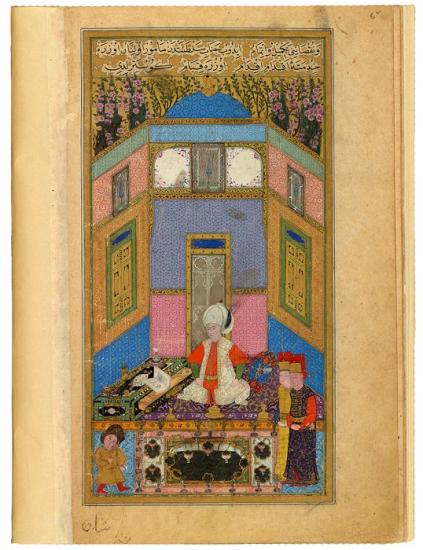
Sultan MurĀd III in his Library
Maṭāli˓ al-sa˓āda wa manābi˓ al-siyāda (The Ascension of Propitious Stars and Sources of Sovereign), in Turkish
Illuminated by Vali Jan for ˓Āyisha Sulṭān (d.1604), the daughter of Sultan Murād III
Purchased in 1935
Murād III (r. 1574–95), the son of Selim II (r, 1566–74) and grandson of Süleyman the Magnificent (r. 1520–66), ushered in a golden age of Ottoman painting, commissioning illustrated manuscripts of historical, literary, and scientific texts, many made in Istanbul's imperial scriptorium. He also ordered that texts be translated into Turkish.
Here Murād III actually admires the very manuscript for which this is the opening miniature—-the Maṭāli˓ al-sa˓āda, made for his daughter ˓Āyisha Sulṭān.; He is examining the section of the manuscript depicting zodiacal signs and the three planets associated with their decades. The face of the sultan, alas, has been altered, perhaps by a later owner, as he should have been depicted with a beard, as he is in the closely related miniature in Paris. The book is supported by the open drawer of a luxurious portable desk of ebony and ivory, on top of which are various implements, including an hourglass and a western clock. Murād is attended by two janisarries wearing their elite and distinctive headgear, and a dwarf.
Murād was interested in astronomy, cosmology, demonology, poetry, and mysticism and ordered a Turkish translation (1590) of Aflākī's life of Rūmī, Persia's greatest poet and mystic. Murād wrote poetry, and in 1584 built the kitchen and dervish cells of the Mevlevī convent in Konya, where he had gone with Selim during the siege of 1559 (see MS M.466, fol. 131r). As sultan, Murād never left Istanbul but took full advantage of the imperial harem. By the time of his death at age forty-nine he had fathered one hundred and two children and left seven pregnant concubines; sixty-two died during his lifetime, and nineteen sons were murdered by Mehmed III when he ascended the throne.
Natural History and Astrology
The miniatures presented here derive primarily from two extraordinary Islamic manuscripts that depict the natural world and the heavens. The first, Manāfi˓-i hayavān (The Benefits of Animals), is considered one of the ten greatest surviving Persian manuscripts. It dates from the reign of Ghazan Khan (1295–1304), the Mongol ruler who ordered a Persian translation of the book, and concerns the nature and medicinal properties of humans, animals, birds, reptiles, fish, and insects. The other, Matāli˓ al-sa˓āda wa manābi˓ al-siyāda (The Ascension of Propitious Stars and Sources of Sovereign), was commissioned by Sultan Murād III (r. 1574–95), an Ottoman ruler deeply interested in astronomy, cosmology, demonology, poetry, and mysticism.
Leo Ridden by a Personification of the Sun
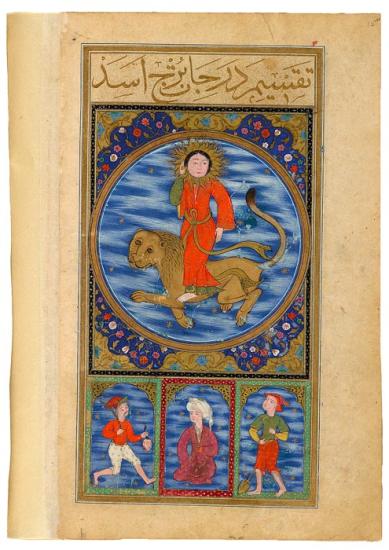
Leo Ridden by a Personification of the Sun
Maṭāli˓ al-sa˓āda wa manābi˓ al-siyāda (The Ascension of Propitious Stars and Sources of Sovereign), in Turkish
Illuminated by Vali Jan for ˓Āyisha Sulṭān (d.1604), the daughter of Sultan Murād III
Purchased in 1935
This astrological illustration is one of twelve in the manuscript that depict the zodiacal signs and the three planets associated with their decades. Leo, the lion, ridden by a personification of the sun, is depicted within the roundel. The lords of the decades are shown in the arcades below: Saturn using a spade, Jupiter holding a book, and Mars holding a mace and severed head.
Natural History and Astrology
The miniatures presented here derive primarily from two extraordinary Islamic manuscripts that depict the natural world and the heavens. The first, Manāfi˓-i hayavān (The Benefits of Animals), is considered one of the ten greatest surviving Persian manuscripts. It dates from the reign of Ghazan Khan (1295–1304), the Mongol ruler who ordered a Persian translation of the book, and concerns the nature and medicinal properties of humans, animals, birds, reptiles, fish, and insects. The other, Matāli˓ al-sa˓āda wa manābi˓ al-siyāda (The Ascension of Propitious Stars and Sources of Sovereign), was commissioned by Sultan Murād III (r. 1574–95), an Ottoman ruler deeply interested in astronomy, cosmology, demonology, poetry, and mysticism.
The Valley of Diamonds and Jewels
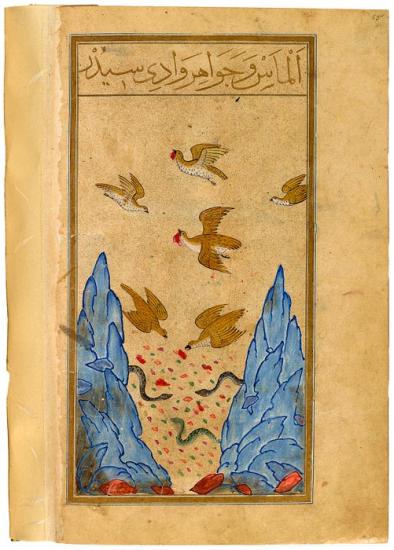
The Valley of Diamonds and Jewels
Maṭāli˓ al-sa˓āda wa manābi˓ al-siyāda (The Ascension of Propitious Stars and Sources of Sovereign), in Turkish
Illuminated by Vali Jan for ˓Āyisha Sulṭān (d.1604), the daughter of Sultan Murād III
Purchased in 1935
In this illustration from a sixteenth-century Turkish manuscript commissioned by Sultan Murād III, the deep rocky valley was filled with diamonds and jewels, and Iskandar (Alexander the Great) was asked how they could be safely obtained, as they were protected by terrible creatures, here represented as poisonous snakes. His solution was to throw raw meat into the valley, to which the gems would stick. The birds would then swoop down into the valley, carry off the gem-laden meat in their talons, and take it to the top, planning to eat the meat there. The birds would then be scared away, and the gems separated from the meat.
Natural History and Astrology
The miniatures presented here derive primarily from two extraordinary Islamic manuscripts that depict the natural world and the heavens. The first, Manāfi˓-i hayavān (The Benefits of Animals), is considered one of the ten greatest surviving Persian manuscripts. It dates from the reign of Ghazan Khan (1295–1304), the Mongol ruler who ordered a Persian translation of the book, and concerns the nature and medicinal properties of humans, animals, birds, reptiles, fish, and insects. The other, Matāli˓ al-sa˓āda wa manābi˓ al-siyāda (The Ascension of Propitious Stars and Sources of Sovereign), was commissioned by Sultan Murād III (r. 1574–95), an Ottoman ruler deeply interested in astronomy, cosmology, demonology, poetry, and mysticism.
Sleeping Man

A Sleeping Man is Oppressed by a Nightmare
Maṭāli˓ al-sa˓āda wa manābi˓ al-siyāda (The Ascension of Propitious Stars and Sources of Sovereign), in Turkish
Illuminated by Vali Jan for ˓Āyisha Sulṭān (d.1604), the daughter of Sultan Murād III
Purchased in 1935
According to the title above the painting, this jinn (a pre-Adam angel cast down with Iblīs, or Satan) is called Kabus, which can literally be translated as Nightmare. Jinns are invisible and were created by God, but are half-men and half-animals, and can behave well or badly. They can inflict illness and other ailments, so deserve protective talismans (the gold emblems). Here Kabus, wearing trousers and gold anklets, and accompanied by two horned attendants, swoops down on the man, hoping to ruin his sleep. This illustration appears in a sixteenth-century Turkish manuscript commissioned by Sultan Murād III.
Natural History and Astrology
The miniatures presented here derive primarily from two extraordinary Islamic manuscripts that depict the natural world and the heavens. The first, Manāfi˓-i hayavān (The Benefits of Animals), is considered one of the ten greatest surviving Persian manuscripts. It dates from the reign of Ghazan Khan (1295–1304), the Mongol ruler who ordered a Persian translation of the book, and concerns the nature and medicinal properties of humans, animals, birds, reptiles, fish, and insects. The other, Matāli˓ al-sa˓āda wa manābi˓ al-siyāda (The Ascension of Propitious Stars and Sources of Sovereign), was commissioned by Sultan Murād III (r. 1574–95), an Ottoman ruler deeply interested in astronomy, cosmology, demonology, poetry, and mysticism.
ʻAbd al-Muṭṭalib
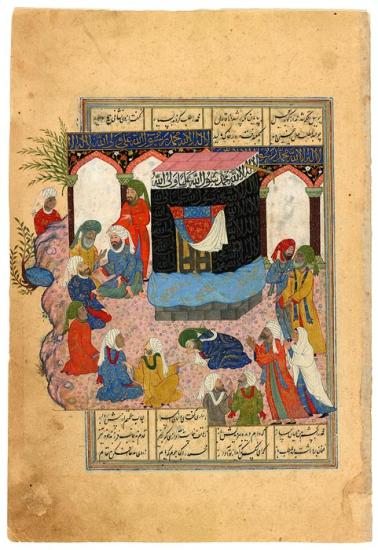
ʻAbd al-Muṭṭalib, Grandfather of the Prophet Muḥammad, Kneels Before the Kabba in Mecca
Leaf from the Chester Beatty Āsār al-muẓaffar (A Life of Muḥammad)
Gift of the Trustees of the William S. Glazier Collection, 1984
The Kaaba (The Cube), the most sacred site in Islam, was, according to the Qur˒an, built by the prophet Abraham and Ismael, his son. Regardless of their location, Muslims always face the Kaaba during prayer. Since Muḥammad's father died nearly six months before his birth, he was brought up for two years with his paternal grandfather, ˓Abd al-Muṭṭalib, who died when Muḥammad was eight. His uncle, Abū ṭālib, custodian of the Kaaba, then looked after him. Here the Kaaba is covered with a black cloth (kiswa) decorated with the shahada (declaration of faith: There is no god but Allah, Muḥammad is the messenger of Allah) and ˓Alī is the friend of God. Before Muḥammad, there were 360 idols in the Kaaba. In another miniature in the Chester Beatty manuscript, he orders their destruction. The style of miniature, the circular composition, and the subject matter anticipate the Baghdad school of painting that flourished from about 1585 to 1605, and of which the Morgan life of Rūmī (MS M. 466) is a masterpiece.
Natural History and Astrology
The miniatures presented here derive primarily from two extraordinary Islamic manuscripts that depict the natural world and the heavens. The first, Manāfi˓-i hayavān (The Benefits of Animals), is considered one of the ten greatest surviving Persian manuscripts. It dates from the reign of Ghazan Khan (1295–1304), the Mongol ruler who ordered a Persian translation of the book, and concerns the nature and medicinal properties of humans, animals, birds, reptiles, fish, and insects. The other, Matāli˓ al-sa˓āda wa manābi˓ al-siyāda (The Ascension of Propitious Stars and Sources of Sovereign), was commissioned by Sultan Murād III (r. 1574–95), an Ottoman ruler deeply interested in astronomy, cosmology, demonology, poetry, and mysticism.